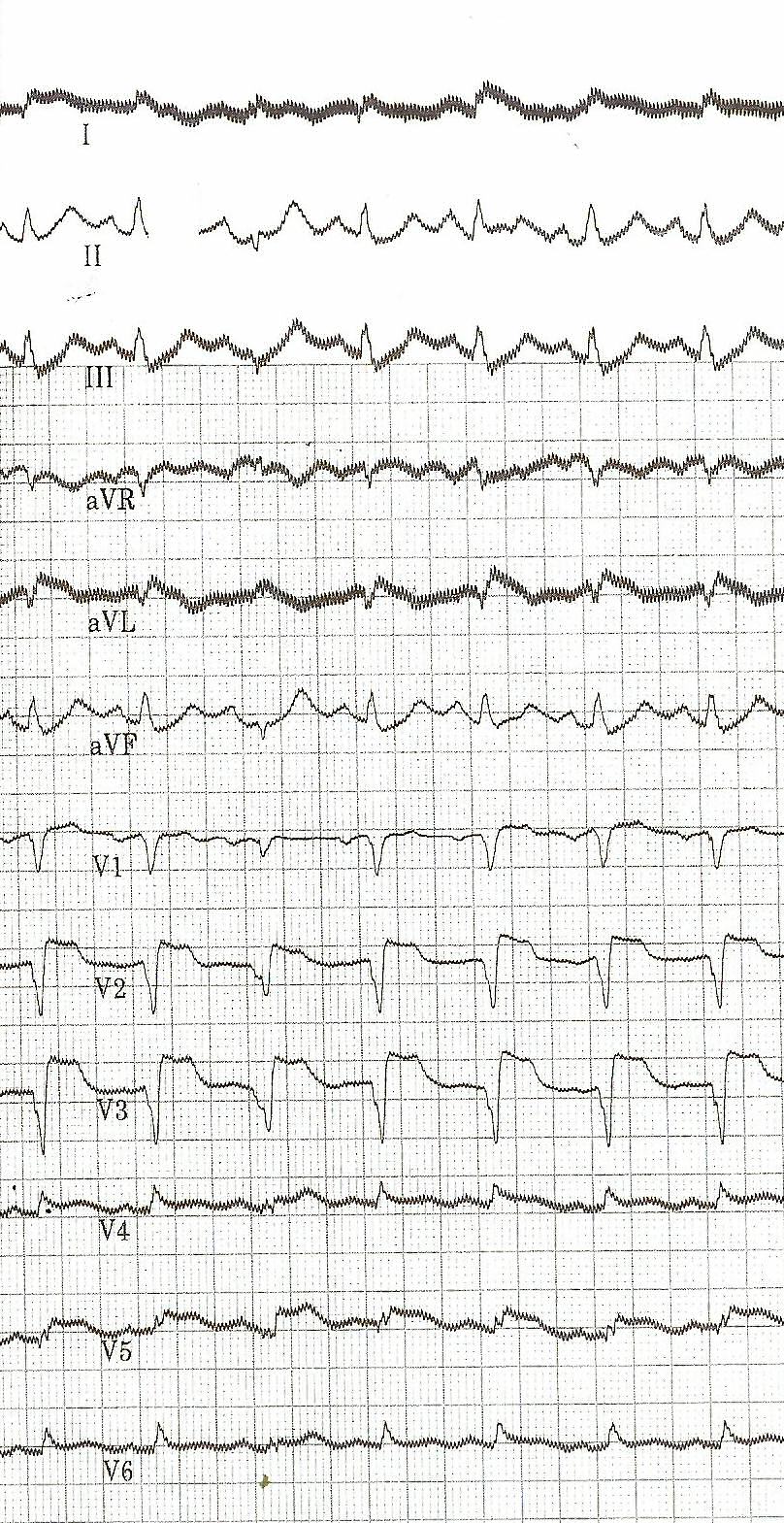Anterior myocardial infarction
| Resident Survival Guide |
|
ST Elevation Myocardial Infarction Microchapters |
|
Differentiating ST elevation myocardial infarction from other Diseases |
|
Diagnosis |
|
Treatment |
|
|
Case Studies |
|
Anterior myocardial infarction On the Web |
|
Directions to Hospitals Treating ST elevation myocardial infarction |
|
Risk calculators and risk factors for Anterior myocardial infarction |
For patient information click here
Editor-In-Chief: C. Michael Gibson, M.S., M.D. [1]
Synonyms and keywords: Anterior MI
Overview
An anterior myocardial infarction (MI) is characterized by the presence of ST elevation in the anterior leads V1 through V6. ST elevation in V1 and V2 corresponds to septal infraction whereas ST elevation in leads V5 and V6 corresponds to apical infarction. Anterior MI results from the total occlusion of the left anterior descending (LAD) artery.
EKG Examples
Shown below is an EKG demonstrating loss of R waves throughout the anterior wall (V1-V6). QS complexes in V3-V5. ST elevation in V1-V5 with terminal negative T waves.

Copyleft image obtained courtesy of, http://en.ecgpedia.org/wiki/Main_Page
Shown below is an EKG demonstrating acute anterior MI. LAD artery occlusion.

Copyleft image obtained courtesy of, http://en.ecgpedia.org/wiki/Main_Page
Shown below is an EKG demonstrating acute anterior myocardial infarction and left anterior hemiblock depicting ST elevation in precordial leads.

Copyleft image obtained courtesy of, http://en.ecgpedia.org/wiki/Main_Page
Shown below is an EKG demonstrating old anterior myocardial infarction and bifascicular block (RBBB and LAHB) as indicated in the anterior chest leads.

Copyleft image obtained courtesy of, http://en.ecgpedia.org/wiki/Main_Page
Shown below is an EKG illustrating acute MI with proximal LAD occlusion depicting ST elevation in anterior precordial leads.

Copyleft image obtained courtesy of, http://en.ecgpedia.org/wiki/Main_Page
Shown below is an EKG demonstrating a 2 days old anterior infarction with Q waves in V1-V4 with persisting ST elevation, a sign of left ventricular aneurysm formation.

Copyleft image obtained courtesy of, http://en.ecgpedia.org/wiki/Main_Page
Shown below is an EKG demonstrating a 2 weeks old anterior infarction with Q waves in V2-V4 and persisting ST elevation, a sign of left ventricular aneurysm formation.

Copyleft image obtained courtesy of, http://en.ecgpedia.org/wiki/Main_Page
Shown below is an EKG demonstrating a large anterior wall infarction on admission. This image depicts ST elevation in V2-V5 leads.

Copyleft image obtained courtesy of, http://en.ecgpedia.org/wiki/Main_Page
Shown below is an EKG demonstrating sinus rhythm. The remarkable feature is the poor R wave progression in the V1 and V2 leads and the ST elevation and T wave changes in leads V1 to V4 and I and aVL. The cardiogram suggests an anterior/ lateral MI possibly acute. There is also terminal P wave negativity in V1 suggesting a left atrial abnormality.

Copyleft image obtained courtesy of, http://en.ecgpedia.org/wiki/File:E209.jpg
Shown below is an EKG showing sinus rhythm with anteroseptal myocardial infarction depicting ST elevation in V1-V6 and in lead I.

Copyleft image obtained courtesy of, http://en.ecgpedia.org/wiki/Main_Page
Shown below is an EKG demonstrating acute myocardial infarction in in a patient with a pacemaker and LBBB. Concordant ST elevation in V5-V6 are clearly visible. There is discordant ST segment elevation > 5 mm in lead V3.

Copyleft image obtained courtesy of,http://en.ecgpedia.org/wiki/Main_Page
Shown below is an EKG showing ST elevation MI.

Copyleft image obtained courtesy of, http://en.ecgpedia.org/wiki/File:De-KJcasus12.jpg
Shown below is an EKG showing ST elevation in the anterior precordial leads, low voltages in all the leads, poor R wave progression in the precordial leads.

Copyleft image obtained courtesy of, http://en.ecgpedia.org/wiki/File:De-AMI_anterior_LAD_2days.jpg
Shown below is an EKG demonstrating ST segment elevation in precordial leads signifying anterior myocardial infarction.

Copyleft image obtained courtesy of, http://en.ecgpedia.org/wiki/File:De-AMI_anterior.png
Shown below is an EKG showing sinus rhythm with abnormal QRS and a Q wave in lead V2 which is suggestive of a previous anterior wall myocardial infarction.

Copyleft image obtained courtesy of, http://en.ecgpedia.org/wiki/File:E289.jpg